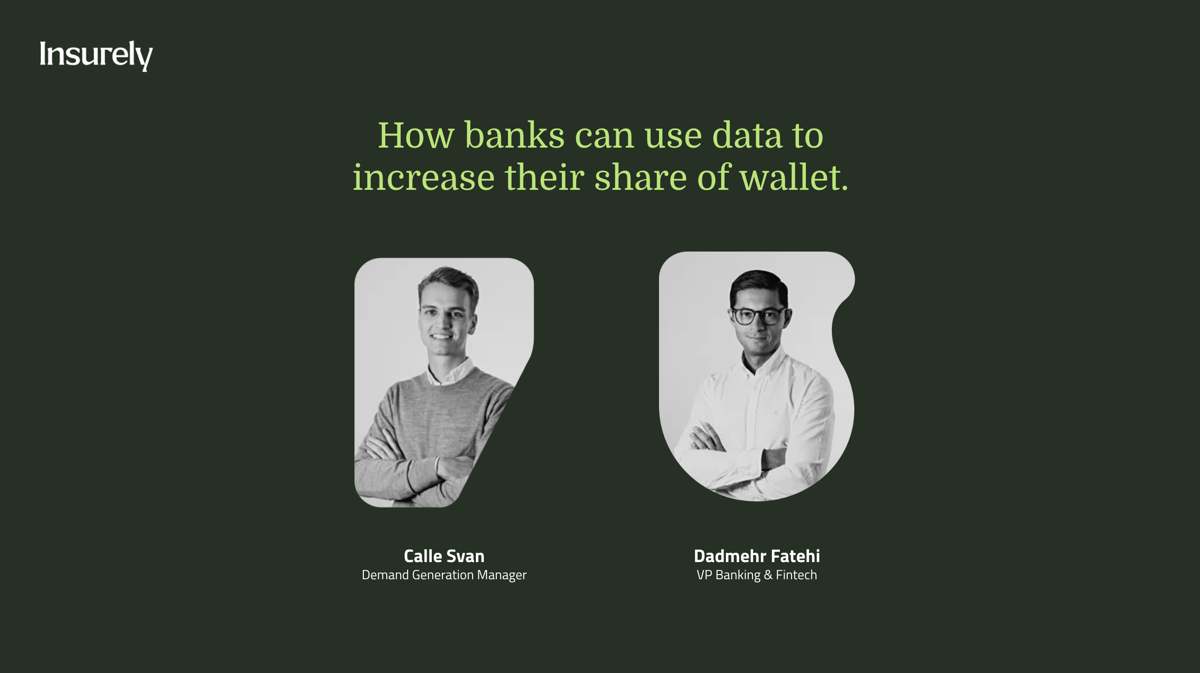
Webinar recap: How banks can use data to increase their share of wallet.
In today's fiercely competitive banking industry, harnessing data effectively has become a critical factor for meeting customer demands and expanding market share. Our recent webinar featured Insurely's VP of Banking & Fintech, Dadmehr Fatehi, who together with our Demand Generation Manager, Calle Svan, delved into the transformative potential of data-driven strategies in banking.
In this blog post, we'll provide a concise recap of the key discussions and insights shared during the event.
The webinar started with a discussion about the current change going on in the financial sector, and how making change happen in the financial industry has been really difficult over the years. Every now and then there is a new innovation, a new service or an interesting start-up trying to disrupt the market, but that’s rarely the case. However, now, for various reasons, the change really is starting to happen. Which is mainly driven by two factors, Dadmehr explained:
“First, there are upcoming regulations within the EU being developed as we speak, which will make insurance and pension more transparent for the consumer. And secondly, we have the constantly increasing consumer demands. Consumers are used to getting everything at the fingertips, they have high expectations on speed, usability, experience and transparency from all their service providers. So why should insurance providers and banks be any different?”
As a bank you need to start thinking about these two forces, upcoming regulations and consumer demands, and how to adapt to them. Consumers are open to using new technology if it provides them with a better and more seamless financial experience. For example, Swish, Venmo, Stripe or electronic identification services, like the Swedish BankID.
Leveraging trust
Trust has always been a leading value for banks. Consumers trust their bank, and that their bank always has their best interest in mind. However, in the past decade, people are moving more of their financial matters to challengers, such as fintechs and other new service providers. The new digital landscape thereby creates a situation with both more competition, but also more opportunities.
“What banks should look at,” Dadmehr explained, “is exploring how they can leverage the trust and loyalty they already have with their customers , while applying the concepts and approaches that the challengers or fintechs in the industry do. By doing so, they can become the go-to place for consumers, offering both the legacy and trust, and the cutting-edge modern experiences. And how would that work in reality? The answer is real-time customer data. Banks have already started doing this since PSD2, but the new types of data that will be available through the open finance framework, like insurance data and pension data, will allow new use cases to be created, that will bring in more revenue streams to the banks. "
Some examples
Pension is a good example of how banks can win back and/or keep that share of wallet, where challengers are starting to take increasingly more pieces of the pie. As Dadmehr explained:
“Pension can often be difficult for the consumer to understand. That’s where the pension data plays a huge part; in making the consumer grasp what they have today and what they pay in fees by having the pension spread out across different institutions. With open data, banks can help the consumer understand what they would win by consolidating their pension to one single place, for example reduce fees by X% and in the end get 30.000€ more on the day they retire. That’s pretty appealing to consumers.”
Another space of great revenue potential is bancassurance, which would be to use the data to access a completely new part of the wallet.
Dadmehr used the easy-to-grasp example of when a consumer buys a new home.
“They’ll need two things: a mortgage and a home insurance. Why doesn’t the bank offer a more holistic solution here? They already have all the information they need to be able to offer a suitable policy with the best possible coverage for their new home. And of course, they already know that this customer needs home insurance.”
Key take aways
Harnessing data to increase banks' share of wallet: By utilizing real-time customer data and exploring new data sources such as insurance and pension data, banks can identify opportunities to develop innovative services, regain lost market share, and drive additional revenue streams.
Adapting to regulatory changes and consumer demands: The financial industry is undergoing significant changes driven by two main factors: regulatory changes and evolving consumer demands. Regulatory shifts, such as the upcoming open finance framework within the EU, present opportunities for banks to embrace digitalization in a consumer-friendly manner and capitalize on open banking. Additionally, consumers expect seamless, transparent, and personalized financial experiences similar to the convenience they enjoy in other sectors. Banks need to adapt by leveraging technology and meeting these expectations to remain competitive.
Leveraing trust and loyalty: Consumers inherently trust their banks and that banks always have their best interests are taken into account. However, with the rise of fintech challengers and new service providers, banks face increased competition. To maintain their position and become the go-to destination for consumers, banks can leverage their existing trust and loyalty by applying innovative concepts and approaches. Real-time customer data plays a crucial role in understanding customer needs and preferences, enabling banks to offer personalized services, regain market share, and enhance revenue.
If you’re curious to know more about what we do and how we do it, just reach out.

